With games like Jill of the Jungle, Rick Dangerous, and James Pond 2, the PC wasn't exactly spoiled for great platformers back in the day
We're rerunning Richard Cobbett's classic Crapshoot column, in which he rolled the dice and took a chance on obscure games—both good and bad.
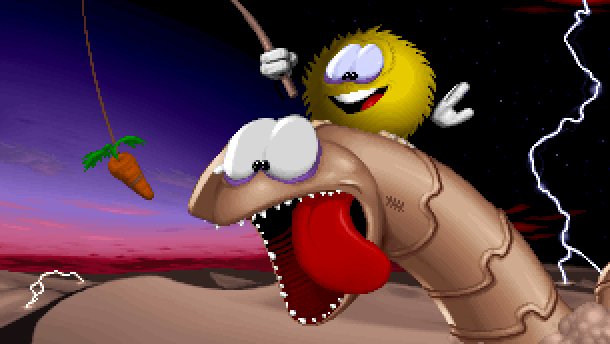
From 2010 to 2014 Richard Cobbett wrote Crapshoot, a column about rolling the dice to bring random games back into the light. This week, rather than one game, a bit of a medley. The PC's always been the best platform, obviously. When it came to platformers though...
Yes, once again, thanks to getting hours into this week's intended subject only to be stopped by an unfixable crash, it's time for a look at a random grab-bag of what was historically one of the PC's weakest genres. If you wanted platformers you got a Nintendo, an Amiga/ST, or if your parents secretly hated you, a Sega. It's not that there weren't attempts made on PC, just that they rarely worked out that well (remember our version of Mega Man?) and were too expensive to risk a punt on compared to something likely to last longer, like an adventure, an RPG, or a Slush Puppie. Let's take a random spin through some of the good and the bad, and the very, very ugly.
The Adventures of Captain Comic
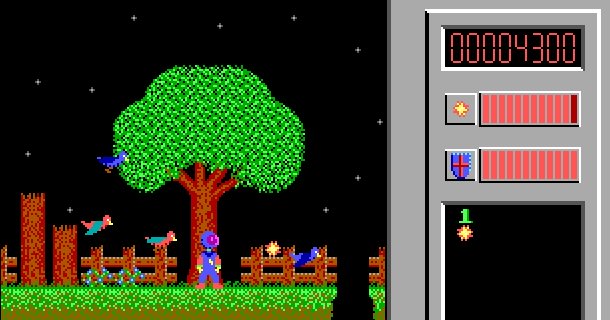
Where better to start than right at the beginning, more or less. Captain Comic is often credited as being the first PC platformer, though a quick look at the graphics, simple as they are, should be a clue that it's not. It came out in 1988, while players craving disappointment could have been playing the likes of Ario Bros (sic) as early as 1983. You can probably work out what game that was a clone of, and note the lack of the word 'Super' in its name. Its graphics consisted entirely of ASCII figures, with Mario replaced with a smiley face and Shigeru Miyamoto with a dodgy photocopier.
Captain Comic was however arguably the first that became iconic, due to being released as shareware and thus appearing constantly whenever magazine disk editors needed to fill a little space, or shareware editors got bored of Shooting Gallery and whatever Skunny was up to that week.
It's not a complicated game, as if the name "Captain Comic" wasn't a bit of a clue, but it's more advanced than you might think. It bothers with a few things that many games that followed wouldn't, including correcting a jump in the air, as well as taking the view that if you had a gun, you'd probably want to use it. True, it's powered by soda for some reason, and no "Captain Comic" will ever be badass, but shareware of a similar vintage would regularly restrict you to just a few shots so they had something to use as a pick-up. Here, you can fire almost as much as you want (with an energy meter offering mild limitations), and each gun upgrade means being able to shoot more projectiles at once.
Weird that the default 'shoot' command key was 'Ins' though. Look on your keyboard. Yes. That one.
It's a simple enough platformer, not really notable for anything but getting in there first, but did start a bit of a trend: shareware developers desperately trying to make the genre work. If a new game was held up as the PC's answer to, say, Sonic the Hedgehog, it was going to be a shareware game. Even if it was the original Duke Nukem, back in the days where he wore pink, wasn't sure how to spell his name, and wanted to be done with his ass-kickery in time to get home and watch Oprah.
Keep up to date with the most important stories and the best deals, as picked by the PC Gamer team.
It probably goes without saying that none of them were that successful, at least until what was then called Epic Megagames got into the action with a little game called Jazz Jackrabbit. Prior to that, though...
Jill of the Jungle
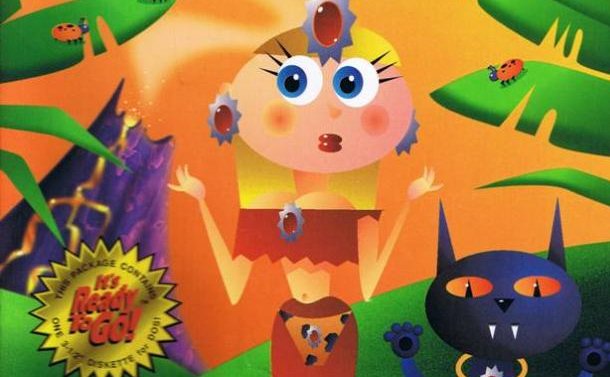
Even as far back as 1992, people were rolling their eyes at the classic 'prince saves princess', 'rescue the kidnapped girlfriend' storyline, so it's a good job that it's never used any more, right? Few remarked on it as openly as Jill of the Jungle, with its colour-swapping heroine fighting her way through some of the blockiest platforms ever to be jumped on, and a third episode called "Jill Saves The Prince" featuring the most romantic, epic ending ever. Or possibly the most favor-y favour ever to be requested.
THE PRINCE ASKS: "Jill of the Jungle, you have not only saved my life, you have saved the jungle from great peril. You have the eternal gratitude of my family. Now I ask you only one more favor, Jill... will you marry me?"
JILL ANSWERS: "Okay."
Sniff. Truly, a legendary tale.
The game itself was very primitive, being notable mostly for its gradient backgrounds and having a non-sexualised (unless you squint, or look at the box, which was a different and much sillier story) female protagonist. It wasn't the first, earlier games like The Colonel's Bequest, Plundered Hearts, and King's Quest 4 already having broken that ground, but it was still a rarity. Not like today, of course.
That makes it all the stranger that the game intended to be Jill of the Jungle's follow-up ended up morphing into an original game called... wait for it... "Vinyl Goddess From Mars." With a name like that on its title screen, a game only has two possible ways to go. See if you can guess which one it chose!
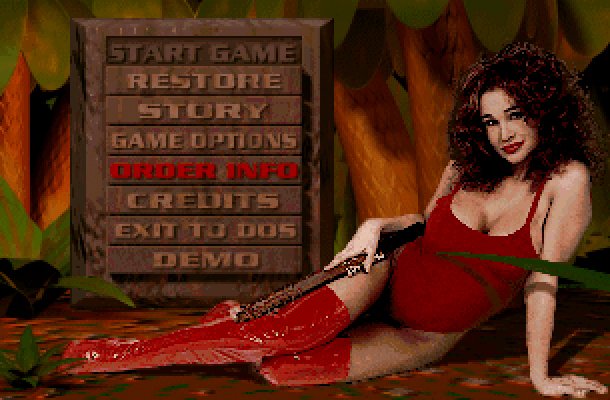
You guessed correctly. Jill of the Jungle did, however, put Epic Megagames and its creator Tim Sweeney on the map. A few years later, he would go on to create the Unreal engine, which of course powers much of the industry right now. In a very real sense, a sizeable chunk of the games industry owes its existence to this platforming blonde in a bathing suit, and Jazz Jackrabbit, the bright green rabbit that followed her. Not so much its official follow-up Xargon though, since even fans of Epic Megagames in the day tended to call it "That Game That Also Exists."
Jazz Jackrabbit was a fantastic game for its time, 'fantastic' in this case admittedly needing to be followed with 'if you envied console owners their 16-bit platformers but hadn't really played enough of them'. It had awesome music, seemingly endless levels, 3D bonuses and more, and for a while was hands-down the best mascot platformer you could get on the PC, shareware or not.
Jazz Jackrabbit was followed by a sequel, which paired Jazz with the unfortunately named partner "Spaz" (more of a deal in the UK than in the US, I suspect) and a 3D version was in production for a while. It's not hard to find a copy of that if you poke around, but I wouldn't bother. It's very primitive stuff. The original shareware version though? I had some great times with that, and it's one of the very few shareware games I ever personally registered with my pocket money. When I could get the whole game for about £10, anyway.
But shareware couldn't have the whole genre to itself. What wonders awaited on the shelves?
Trolls

No.
James Pond: Robocod
Given that his entire series was little more than a pun with a couple of prosthetic games attached, James Pond did pretty well for himself. Only one of his adventures made it onto DOS though, and it wasn't the platforming that made it infamous. The platforming was okay , in the strongest, most hand-wavey sense of okay imaginable, as everyone's favourite fish became everyone's favourite fish-and-chips thanks to some cyborg technology that let him stretch up and grab platforms.
It also marked a confusing point for the industry, as everyone tried to work out whether levels filled almost entirely with Penguin chocolate bars in their wrapping counted as either a cool acknowledgement that games were important enough to get that honour, or just a bit tacky. A few more years of product placement would of course confirm the latter, from the Chupa Chups in Zool: Ninja Ant From the Nth Dimension Whatever its Creators Thought, to platform and puzzle games based on the Quavers mascot, to Space Quest 5 ending all futuristic phonecalls with "Thanks for using U.S. Sprint!"

Robocod's crowning achievement on PC though was to be one of the most glorious demo cock-ups of all time. The demo was cover-mounted on our sister magazine PC Format, along with probably a few other places, and on the surface was fairly standard. You got a couple of levels, which was likely enough to realise that the game was okay but you didn't really want any more of it. Your mileage may vary there, but since far more people remember Robocod fondly than actually bought it, the odds were pretty good. The problem was that to make this demo, the creators simply dumped the whole game on a disk and flipped a switch to stop the doors to the levels unlocking after the first couple.
But forgot to switch off the 'access all levels' cheat code.
As a result, the entire game was playable from the coverdisk simply by tapping a few items in the right order at the start of the game. This was a well known code at the time, and so an obvious thing to try and be stunned when it actually worked. As I remember, the only thing that was missing was the ending—the game just crashing there. Since the ending consisted entirely of Santa dropping a bag of toys on the villain and he and Robocod jumping up and down, it wasn't worth investing in the whole game for.
If anyone does feel any lingering guilt though, there's always a chance of a revival. I don't know if they've decided on a pun, but the good money is on Tomorrow Never Fries or License To Krill.
Fury of the Furries
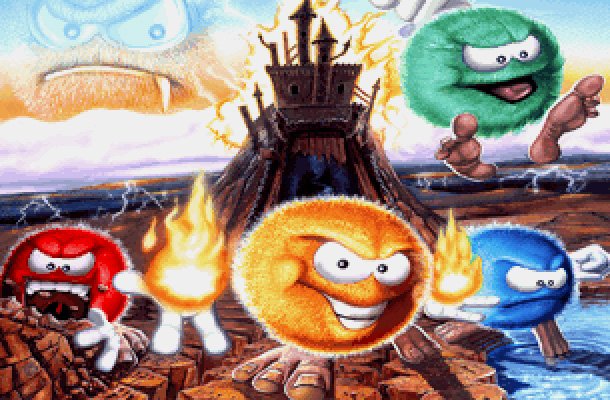
Now, here's one for the 'forgotten classic' category. Fury of the Furries (later redrawn and re-released as the Pacman game Pac-In-Time, one of several attempts to break out of the maze and make a game nobody wanted, the most bizarre being the semi-point-and-click adventure Pac-Man 2: The New Adventures) was a slow-burning but terrific mix of platforming and puzzling. Its plot was an irrelevance, its graphics hardly worth mentioning. Its feel though was great.
You controlled a gang of furballs called Tinies, or one colour-changing one, with coloured gates determining which powers you can call on at any time. Red can devour platforms, yellow shoots fire, blue is the diving specialist. King of all of them is Green, who can travel around the map via unlimited ninja ropes. This was extremely cool, especially as it was much more forgiving than the more famous rope over in Worms.
There's not a lot more to say about Fury of the Furries. It was just a simple idea, really well executed. Also, along with French, English, German, and a couple of other languages, you could choose to play the game in Fremen. As in Dune. This didn't change a lot, really, it not exactly being a plot-heavy game. It did however mean things like the opening desert level being renamed Arrakis, and selecting 'Bazir al Kalash' for sound settings. Kalah, or Neb kalash? It comes on a stick. Wash it down with some Crab Juice.
It's good to remember that '90s platformers weren't all bad. Right. What's next?
Trolls

Christ, no.
Rick Dangerous
Rick Dangerous was a defining game for me. Specifically, it defined what I wasn't willing to accept in a game, which in this case is sadistic, brutal death, where survival is less about skill than rote memorisation. For some reason though, just about everyone I've ever spoken to who remembers these two games does so with eyes so misty they should probably get windscreen wipers.
Both are about the adventures of an Indiana Jones-type, with the first game (from 1989) set in his natural habitat—caves full of rolling boulders and the like—and the second taking on a more sci-fi vibe, with the box riffing on Flash Gordon and Rick fight off invading aliens. Between deaths, anyway.

In both cases the stock joke was that Rick wasn't dangerous, his games were. Some say that diamond is the hardest material in the world, show-offs sniff that it's actually wurtzite boron nitride. Both though are incorrect. Beating them all into a bloody mess is the cranium of anyone who willingly made it through these games.
They're not the toughest ever made or anything, just a relentless death march of traps and screw-you design, with limited lives to really rub salt into the wound. On the very first screen of the first game you start in a corridor. As soon as you move, a boulder starts rolling right behind you, chasing you down a passageway with only a second or so head-start... a passageway that then drops you straight onto an enemy who kills you in one hit. In game design terms, that's up there with having a convicted poisoner cook you an almond cake. It just gets worse from there.
Still, if you're in the mood for its trial-by-ordeal, there's a modern PC port that at least helps make the controls slightly less horrible. You may also enjoy the experience of repeatedly stepping on a rake.
Trolls
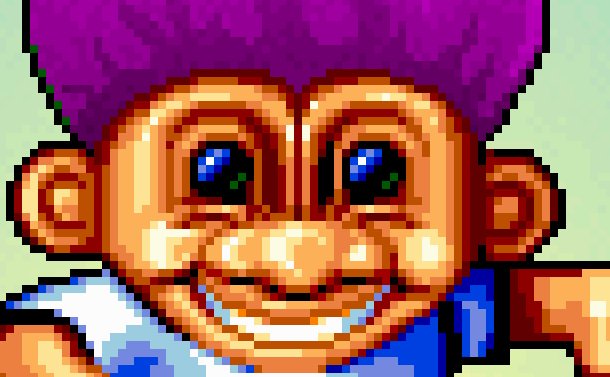
So, it's like that, is it? Very well.
Under normal circumstances, I'd feel sorry for the creators of Trolls. In this case though, I can think of no more fitting punishment for having made Trolls than having to spend extended periods of time in its company—forced to build and then play the most eye-gouging platformer ever to hit the PC.
Based on the long-haired horror toys from the '90s, Trolls used so many neon gradients it caused a worldwide colour shortage. For the three months after it came out, every game was black and white. (Luckily, they were all later secretly patched back to their intended form by an army of magic elves.)
Could it be worse? Well, yes. Slightly. The box could have been the kind of thing that would get you put on a list just for picking it up off the shelf. It would have required a second deal with Satan though, and even he has his limits. "Dude, seriously," he might say. "I already let you make a game with the same effect as opening the Ark of the Covenant. Chillax. Have a cappucino."
Trolls, stripped of the graphics and the fact that it's about Trolls, isn't the worst in the world, though the migraine it brings on can feel like it. The goal is to get around the levels and rescue baby trolls without thinking that the presence of baby trolls means that these hideous abominations must occasionally slip off their T-Shirts and jeans to make the beast with two backs and 10 gallons of hair gel.
Your weapon is a yo-yo, because it's hard to bind 'the sudden existential horror of realising you're in a Trolls game' to the Ctrl key, with themed levels ranging from "Just Took Ecstasy And Stared Into a Kaleidoscope World" to "Synaesthete at a Rock Concert Land." Something like that, anyway. This is the only game ever made that could have done with a sewer level to break up its imagination.
On the plus side, it wasn't a broken interactive movie from the '90s that I now plan to take outside and use as a frisbee, possibly hard enough to not simply break it into shards but atomise it into failure dust. Next week, a more reliable game, or a noose. Stay tuned for updates. (No noose is good news.)

